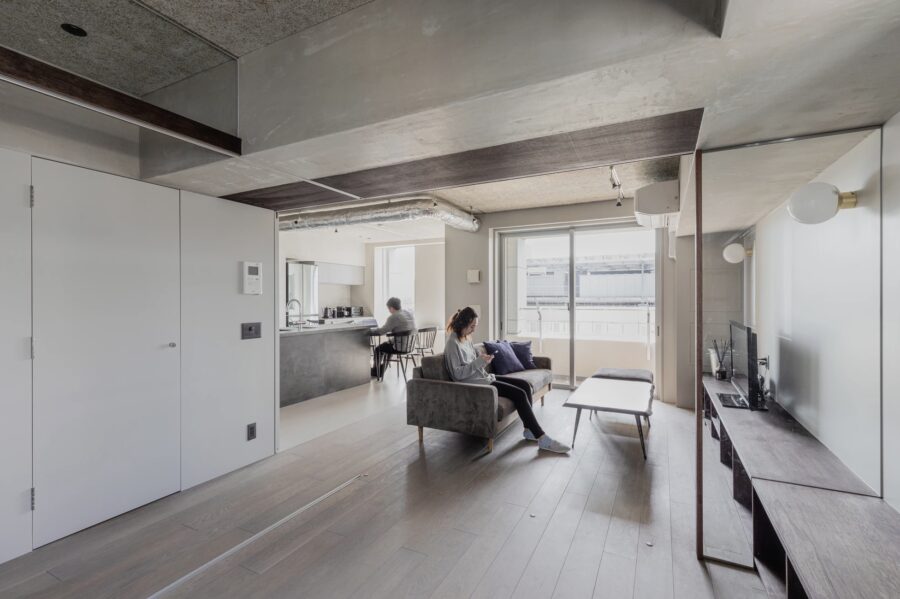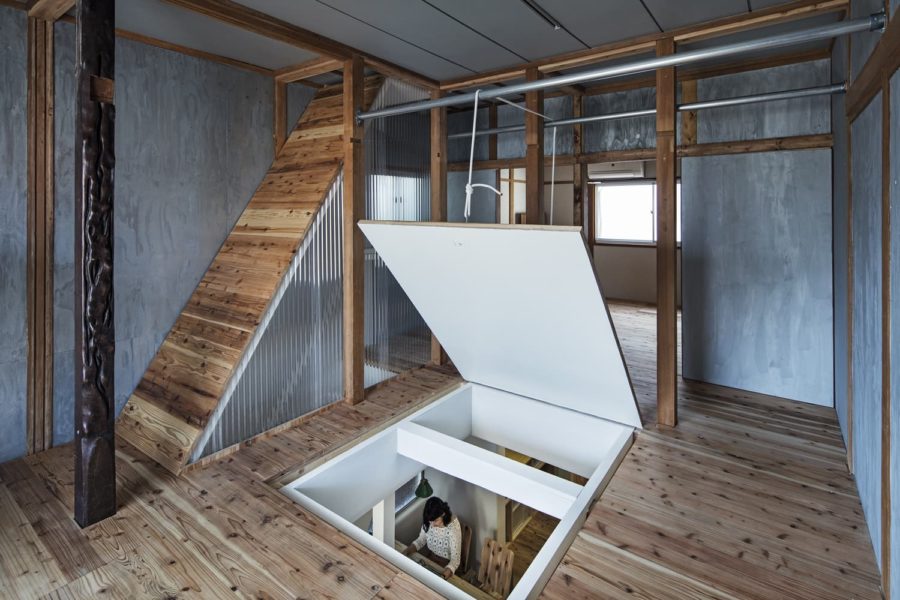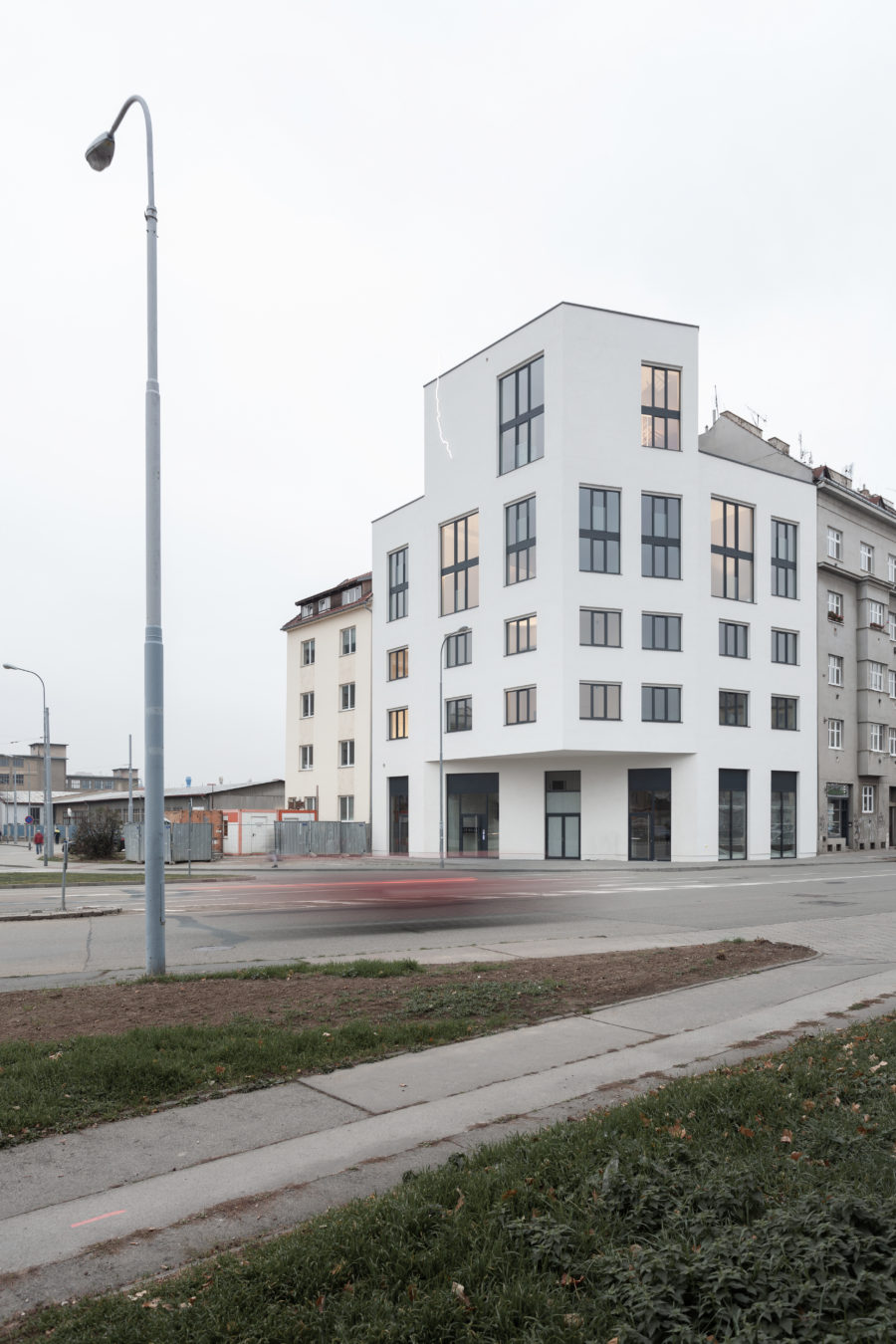大阪市中央区に誕生した、主に外国人観光客を対象とした宿泊施設。
かつては鍛冶屋町として栄え、事業主の先代より続く鍵・金物を取り扱う企業のオフィスビルを擁していた敷地は、拠点の移転に伴い、この土地にふさわしい新たな活用方法が模索されていた。そこで、日本と往復しながら長い海外生活をバックボーンにもつ事業主により、この土地の歴史を継承しながら海外の友人や外国人観光客をもてなすための施設が計画された。同時に画一的な街並みに潤いを与える「都会のオアシス」となるよう、収益性の追及ではない宿泊施設のあり方が求められた。
通常であれば高層化が可能であった敷地に対し、「容積消化をしない」という選択をしたことが、さまざまな面で有効に機能した。例えば、建物配置を道路より大きくセットバックすることで、沿道に対してポケットパークとしての窪みを与えた。同時に既存建物の外形ラインより小さくなったことで、既存地下外壁を土留として利用し、解体で与える周囲への影響が縮小した。また、将来的な間仕切りの転用やプランニングの自由度を上げるために採用したRCラーメン構造も、法的制約・効率の優先度を上げると最小限のバルコニーが並ぶ画一的なファサードを形成してしまうが、先端に花壇のある奥行きの深いバルコニーとし、あえてレンタブル比が下がる手法を取った。これらが日射遮蔽にも有効に機能しつつ、生きた中間領域を形成している。ファサードからは柱・梁の要素をテーパーを付けて消し、マッシブな形態に対比し、木箱が浮遊するアイコン性の高い構成とした。
宿泊室は事業主が一人ひとり丁寧に対応を行えるよう室数を4室に限定し、無理なく維持管理・運営を行えるようにした。各室は約40-140m²のメゾネット型までゆったりとした客室面積を確保し、それぞれが違うテーマ・プランで多種多様な宿泊モデルに対応可能な構成としている。
また、もう1つのテーマとして海外の宿泊者が日本の文化を感じる空間とすることが求められた。ここでは、格子や障子などをエレメントとして取り入れながらも、多様な要素を受入れ調和していく日本の自然観を体現することに重点を置いた。仕上を単一化すれば1つの空間として強く認識されるが、床・壁・天井で日本古来の伝統色の珪藻土などを各面で色を変えながら施すことで、面としての構成要素の認識が強くなる。そこで生まれる面同士の関係性、例えば違う色の取り合いで起きる色の滲みや、黒ではない色のある影の発生など、複雑で多様な情報が空間の雰囲気を形成する。
また、事業主が海外で収集した美術品や調度品、既存建物で使用していた扉・金物、先代より受け継いだ着物の端切れや旧家の雪見障子など、多種多様なものをすべて受け入れて空間の構成要素とすることで、それら多様な情報が混ざり合い調和し、どこの部屋にいても不思議と同じような居心地や空気感を纏う空間が形成されるにいたった。(八木俊典)
An oasis of accommodation surrounded by buildings due to a generous intermediate area
This accommodation facility was created in Chuo-ku, Osaka City, mainly targeting foreign tourists.
The site used to be a prosperous kajiya-machi (blacksmith town), and the owner’s predecessor had an office building for a company that dealt with locks and hardware. The owner of the business, who has a long history of living abroad while traveling back and forth from Japan, planned a facility to welcome overseas friends and foreign tourists while continuing to carry on the history of the land. At the same time, the project was not designed to be a profitable lodging facility but rather an “urban oasis” that would enrich the uniformity of the cityscape.
The choice of “not to use the floor area” for the site, which would normally have allowed for high-rise buildings, worked effectively in various aspects. For example, the building layout was set back from the street to create a pocket park along the street. At the same time, the existing basement exterior wall was used as a retaining wall because it was smaller than the exterior line of the existing building, thereby reducing the impact of demolition on the surrounding area. The RC ramen structure, which was adopted to increase the flexibility of future partitioning and planning, would have created a uniform façade with a minimum number of balconies if legal restrictions and efficiency were given higher priority. The lentable ratio is lowered by making it a deep balcony with a flowerbed at the tip. These balconies function effectively in shielding the building from the sun while at the same time creating a living, intermediate area. The tapered columns and beams were removed from the facade to create a highly iconic composition of floating wooden boxes in contrast to the massive form of the building.
The number of accommodation rooms was limited to four so that the owner could provide careful care to each individual and maintain and manage without difficulty. The rooms range from 40 to 140 m², each with a different theme and plan to accommodate various accommodation models.
Another theme was creating a space where overseas guests could experience Japanese culture. While incorporating elements such as latticework and shoji screens, the emphasis was placed on embodying the Japanese view of nature, which accepts and harmonizes diverse elements. If the finishes were unified, the space would be strongly perceived as a single space. Still, using diatomaceous earth and other traditional Japanese colors on the floor, walls, and ceiling, with each surface having a different color, strengthens the perception of the components as surfaces. The relationship between the surfaces, for example, the blotting out of colors caused by the combination of different colors and the generation of shadows with colors that are not black, create complex and diverse information that forms the atmosphere of the space.
In addition, by accepting a wide variety of objects such as artworks and furnishings collected overseas by the owner, doors, and hardware used in the existing building, scraps of kimono inherited from the previous generation, and yukimi shoji screens from the old house, all of which are used as components of the space, this diverse information is blended and harmonized, and no matter where you are in the room, you will find that you are strangely clad in the same kind of The result is a space that has the same coziness and atmosphere no matter where you are in the room. (Toshinori Yagi)
【SMITH OASIS】
所在地:大阪府大阪市中央区島之内2-12-21
用途:ゲストハウス
クライアント:個人
竣工:2022年
設計:Agg.一級建築士事務所
担当:八木俊典
施工:アーキッシュギャラリー
撮影:杉野 圭
工事種別:新築
構造:RC造
規模:地上5階
敷地面積:205.40m²
建築面積:141.08m²
延床面積:501.90m²
設計期間:2019.10-2021.03
施工期間:2021.04-2022.05
【SMITH OASIS】
Location: 2-12-21 Shimanochi Chuo-ku, Osaka-shi, Osaka, Japan
Principal use: Guesthouse
Client: Individual
Completion: 2022
Architects: Agg. Architects Office
Design team: Toshinori Yagi
Constructor: ARCHISH & GALLERY
Photographs: Kei Sugino
Construction type: New Building
Main structure: RC
Building scale: 5 stories
Site area: 205.40m²
Building area: 141.08m²
Total floor area: 501.90m²
Design term: 2019.10-2021.03
Construction term: 2021.04-2022.05








